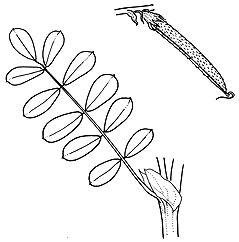Common name: Creeping Darling Pea
Swainsona viridis J.M.Black APNI* 
Description: Prostrate perennial to c. 10 cm high; stems glabrous or sparsely pubescent on young growth with minute, ± appressed, basifixed hairs.
Leaves 1–6 cm long; leaflets 5–13, mostly 7–9, obovate to narrow-obovate, lateral leaflets 5–15 mm long, 2–8 mm wide, apex rounded-truncate to retuse, both surfaces glabrous or mostly with sparse hairs on lower midrib and margins; stipules leafy, c. 5–12 mm long.
Racemes 5–10-flowered; flowers 7–12 mm long. Calyx ± glabrous, teeth longer or shorter than tube. Corolla purple; keel apex obtuse. Style tip with a minute geniculate segment.
Pod narrow-elliptic to cylindrical, 25–35 mm long, glabrous or pubescent; style twisted c. 5 mm long; stipe c. 1 mm long.
Distribution and occurrence: in dry, sandy or stony areas on the banks or in the beds of creeks; not common, Broken Hill district.
NSW subdivisions: NFWP
Other Australian states: S.A.
Threatened species: NSW BCA: Endangered
This species is considered data-deficient by Saving our Species (SoS, DPIE) which means a conservation project cannot be developed for it. Visit their website and contact SoS if you have additional information.
Text by J. Thompson & T. A. James
Taxon concept: Flora of NSW 2 (1991)
APNI* Provides a link to the Australian Plant Name Index (hosted by the Australian National Botanic Gardens) for comprehensive bibliographic data
***The AVH map option provides a detailed interactive Australia wide distribution map drawn from collections held by all major Australian herbaria participating in the Australian Virtual Herbarium project.
|


